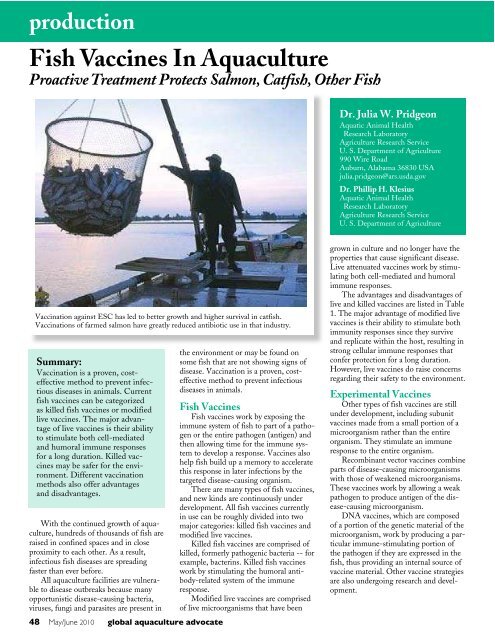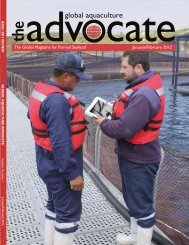May/June 2010 - Global Aquaculture Alliance
May/June 2010 - Global Aquaculture Alliance
May/June 2010 - Global Aquaculture Alliance
Create successful ePaper yourself
Turn your PDF publications into a flip-book with our unique Google optimized e-Paper software.
production<br />
Fish Vaccines In <strong>Aquaculture</strong><br />
Proactive Treatment Protects Salmon, Catfish, Other Fish<br />
Vaccination against ESC has led to better growth and higher survival in catfish.<br />
Vaccinations of farmed salmon have greatly reduced antibiotic use in that industry.<br />
Summary:<br />
Vaccination is a proven, costeffective<br />
method to prevent infectious<br />
diseases in animals. Current<br />
fish vaccines can be categorized<br />
as killed fish vaccines or modified<br />
live vaccines. The major advantage<br />
of live vaccines is their ability<br />
to stimulate both cell-mediated<br />
and humoral immune responses<br />
for a long duration. Killed vaccines<br />
may be safer for the environment.<br />
Different vaccination<br />
methods also offer advantages<br />
and disadvantages.<br />
With the continued growth of aquaculture,<br />
hundreds of thousands of fish are<br />
raised in confined spaces and in close<br />
proximity to each other. As a result,<br />
infectious fish diseases are spreading<br />
faster than ever before.<br />
All aquaculture facilities are vulnerable<br />
to disease outbreaks because many<br />
opportunistic disease-causing bacteria,<br />
viruses, fungi and parasites are present in<br />
the environment or may be found on<br />
some fish that are not showing signs of<br />
disease. Vaccination is a proven, costeffective<br />
method to prevent infectious<br />
diseases in animals.<br />
Fish Vaccines<br />
Fish vaccines work by exposing the<br />
immune system of fish to part of a pathogen<br />
or the entire pathogen (antigen) and<br />
then allowing time for the immune system<br />
to develop a response. Vaccines also<br />
help fish build up a memory to accelerate<br />
this response in later infections by the<br />
targeted disease-causing organism.<br />
There are many types of fish vaccines,<br />
and new kinds are continuously under<br />
development. All fish vaccines currently<br />
in use can be roughly divided into two<br />
major categories: killed fish vaccines and<br />
modified live vaccines.<br />
Killed fish vaccines are comprised of<br />
killed, formerly pathogenic bacteria -- for<br />
example, bacterins. Killed fish vaccines<br />
work by stimulating the humoral antibody-related<br />
system of the immune<br />
response.<br />
Modified live vaccines are comprised<br />
of live microorganisms that have been<br />
Dr. Julia W. Pridgeon<br />
Aquatic Animal Health<br />
Research Laboratory<br />
Agriculture Research Service<br />
U. S. Department of Agriculture<br />
990 Wire Road<br />
Auburn, Alabama 36830 USA<br />
julia.pridgeon@ars.usda.gov<br />
Dr. Phillip H. Klesius<br />
Aquatic Animal Health<br />
Research Laboratory<br />
Agriculture Research Service<br />
U. S. Department of Agriculture<br />
grown in culture and no longer have the<br />
properties that cause significant disease.<br />
Live attenuated vaccines work by stimulating<br />
both cell-mediated and humoral<br />
immune responses.<br />
The advantages and disadvantages of<br />
live and killed vaccines are listed in Table<br />
1. The major advantage of modified live<br />
vaccines is their ability to stimulate both<br />
immunity responses since they survive<br />
and replicate within the host, resulting in<br />
strong cellular immune responses that<br />
confer protection for a long duration.<br />
However, live vaccines do raise concerns<br />
regarding their safety to the environment.<br />
Experimental Vaccines<br />
Other types of fish vaccines are still<br />
under development, including subunit<br />
vaccines made from a small portion of a<br />
microorganism rather than the entire<br />
organism. They stimulate an immune<br />
response to the entire organism.<br />
Recombinant vector vaccines combine<br />
parts of disease-causing microorganisms<br />
with those of weakened microorganisms.<br />
These vaccines work by allowing a weak<br />
pathogen to produce antigen of the disease-causing<br />
microorganism.<br />
DNA vaccines, which are composed<br />
of a portion of the genetic material of the<br />
microorganism, work by producing a particular<br />
immune-stimulating portion of<br />
the pathogen if they are expressed in the<br />
fish, thus providing an internal source of<br />
vaccine material. Other vaccine strategies<br />
are also undergoing research and development.<br />
Vaccine Advantage Disadvantage<br />
Killed No concern it might revert<br />
to a virulent strain in the future<br />
Safe for the environment<br />
Vaccine Delivery<br />
Vaccines are delivered to fish either<br />
by mouth, immersion or injection. Each<br />
approach has advantages and disadvantages<br />
(Table 2). The most effective way<br />
to deliver fish vaccine depends on the<br />
pathogen and its natural route of infection,<br />
the life stage of the fish, production<br />
techniques and other logistical considerations.<br />
A specific route of administration<br />
or even multiple routes may be necessary<br />
for adequate protection.<br />
Applications<br />
Vaccines have been used in food fish,<br />
particularly salmon, for approximately 30<br />
years. They are believed to be one of the<br />
main reasons that salmon production has<br />
been so successful. Vaccination also<br />
dropped the industry’s use of antibiotics<br />
to a mere fraction of its original use. In<br />
1987, approximately 50,000 kg of antibiotics<br />
were used in Norway to control diseases<br />
in salmon. By 1997, when an efficacious<br />
oil-adjuvant vaccine was extensively<br />
used, antibiotic usage had dropped to less<br />
than 2,000 kg, concurrent with a three-<br />
More than one dose may be needed<br />
for initial response, and protection duration<br />
is shorter than modified live vaccines<br />
Typically need to be administrated<br />
by injection, requires labor<br />
Typically need adjuvant to increase efficacy,<br />
which can increase costs<br />
Might revert or change to a virulent strain<br />
years later<br />
Might cause unknown concern to the<br />
environment<br />
fold increase in fish production.<br />
Another example of successful fish<br />
vaccine use has been vaccination against<br />
enteric septicemia of catfish (ESC),<br />
caused by the Gram-negative bacterium<br />
Edwardsiella ictaluri. Fish with ESC<br />
show loss of appetite, restlessness, small<br />
lesions, inflammation of the skin and<br />
erratic swimming. Since 2002, an ESC<br />
vaccine has protected more than 900 million<br />
fish against the disease and provided<br />
13% higher fish survival for producers.<br />
Farm data has also indicated the vaccinated<br />
fish grew faster and had better feed<br />
conversion.<br />
48 <strong>May</strong>/<strong>June</strong> <strong>2010</strong> global aquaculture advocate global aquaculture advocate <strong>May</strong>/<strong>June</strong> <strong>2010</strong> 49<br />
Modified<br />
live<br />
Table 1. Advantages and disadvantages<br />
of killed and modified live vaccines.<br />
Easy immersion administration,<br />
which needs less labor<br />
No adjuvant is needed, which<br />
can reduce costs<br />
Typically high efficacy with only<br />
one treatment, and protection<br />
lasts longer<br />
Table 2. Advantages and disadvantages<br />
of different vaccine deliveries.<br />
Vaccine Advantage Disadvantage<br />
Oral The easiest method because feeding<br />
is a normal part of production<br />
Stress on fish is minimal<br />
Immersion Relatively easy to perform with<br />
minimal interruption to production<br />
schedule<br />
Stress on fish is minimal<br />
Injection Effective for many disease pathogens<br />
Much longer protection duration<br />
Every fish is treated, providing<br />
more assurance to the producer<br />
A coating agent is often needed to avoid<br />
breakdown in fish digestive system<br />
Conveys relatively short immunity,<br />
may require additional vaccination<br />
Smaller, younger fish may have immature<br />
immune systems that require a second<br />
vaccination<br />
<strong>May</strong> not convey protection as effective<br />
as injection for some pathogens<br />
Requires more time and skilled personnel<br />
Fish under 10 g may not respond well<br />
Causes the most stress on fish<br />
The most effective way to<br />
deliver fish vaccine<br />
depends on the pathogen<br />
and its route of infection,<br />
life stage of the fish,<br />
and other logistical<br />
considerations.





